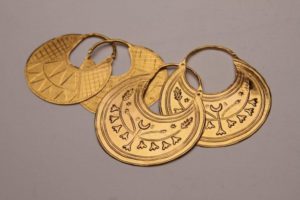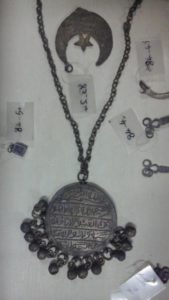Engraving on metals (copper, silver, and gold)
Engraving on metals is a range of arts and skills that engravers have created generation after generation including different symbolic and social dimensions. Hand-engraved tools still have a higher value than modern ones, which, despite their great popularity, do not compete with expensive hand-engraved ones.
The cultural function of the craft is in the motifs, patterns, and uses of the engraved pieces for example one can identify the geographic and social affiliation of a woman or the historic era from the jewelry or engraved utilities, specific engraved motifs for the desert jewelry are distinguished by triangles for example as it is believed that it is a protective motif, additionally, Zar jewelry is characterized by its engraved symbols to satisfy the spirits such as the protection spells which are well known by the practitioners and the craftsmen, it is usually made of silver. Copper engraving is usually in trays, plates, or decoration items, and traditionally the craftsmen engrave botanical, geometric, or verses from the Quraan holly book old mosques contain copper engraved items that go back to the Mamluk era. Engraving on gold is the most sophisticated craft as it required a highly qualified craftsman who can engrave on a tiny and precious surface with no mistakes, the most common motifs on gold are that used in rural communities. Metal engraving workshops are concentrated in the historical Cairo district even it is specialized in a certain type of engraving (for Oasis, deserts, or rural areas). Engraving craftsmanship required specific hammers and carving tools and nails of different types and sizes each has a name and function.




